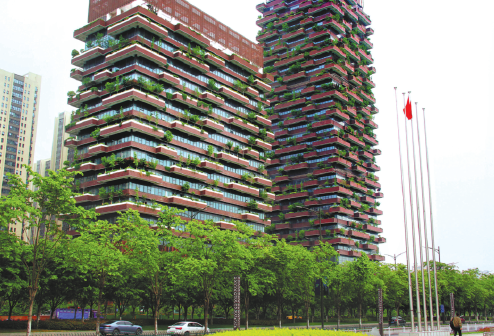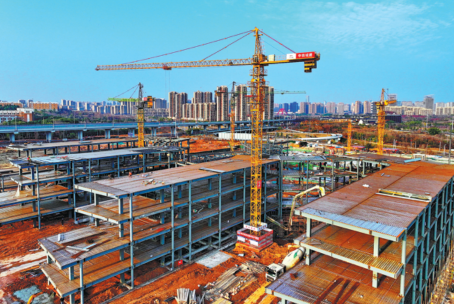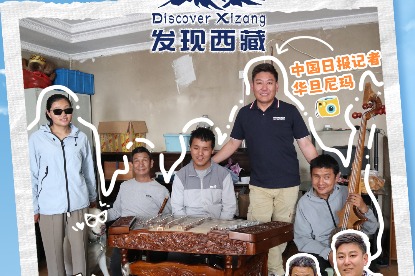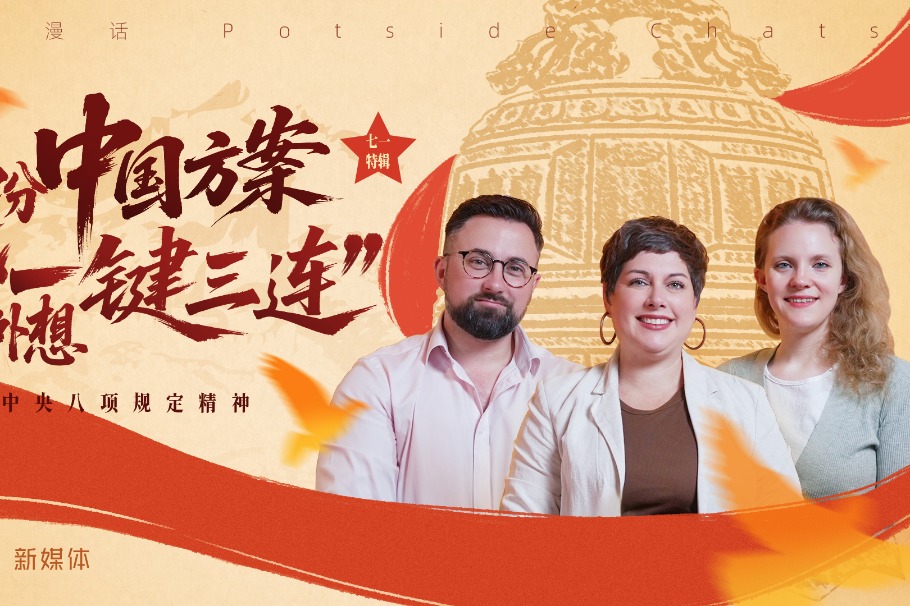Quest for green spaces makes good business sense
Low-carbon lifestyle increasingly favored by young people and is influencing design, energy and construction parameters in a number of key sectors

With the development of ESG(environmental, social and governance), China's pursuit of its "dual-carbon" goals, and consumers' rising awareness of sustainability, the green building industry has become a sunrise industry that is poised for significant growth as it gains prominence in the country.
Green building refers to a building that conserves resources to the utmost (energy conservation, land, water and materials), protects the environment and reduces pollution. It provides a healthy, applicable, and efficient environment for people, while also forming a symbiotic relationship with nature throughout its life-cycle.
Behind the rise of green building, the preference of pursuing a greener lifestyle is gaining traction among a growing number of people. Consumers now increasingly bring their own mugs or bottles when buying coffee. Moreover, LEED (leadership in energy & environmental design) cafes and restaurants are becoming highly popular among the youth as they pay special attention to the LEED marks on the store's window before entering.
The LEED rating system, devised by the United States Green Building Council, assesses the degree to which a building is environmentally friendly, utilizes energy-efficient equipment, and actively adopts renewable energies or other technologies that reduce the negative impacts of buildings on the environment.
"For many young people, ESG is no longer an unattainable concept, but a practical and achievable one. More and more young people are choosing to purchase, use, and promote products with environmental elements and are adopting green, low-carbon lifestyles. This trend is particularly evident in sectors such as food and beverages, household goods, and fashion," said Wang Jing, vice-president of USGBC North Asia.
On Middle Urumqi Road in Jing'an district in Shanghai, there is the world's first LEED Zero Energy pharmacy. Different from regular pharmacies, the LEED Zero Energy pharmacy stores certain drugs in refrigerators, keeping them at a constant temperature and humidity. The refrigerators are energy-saving, and use environmentally friendly refrigerant.
"In terms of daily routine work, we adopt a series of online internal and external office systems to reduce the generation of paper waste. Not only in our stores, but also in our office and logistics systems, we have gradually achieved paperless and electronic documentation, as well as the use of recyclable turnover boxes. In addition, for unavoidable waste such as pharmaceutical packaging, we also conduct detailed classification and collection in accordance with LEED requirements to better realize the resource utilization of garbage," said Yang Ge, senior vice-president of Cowell Health, the parent company of Cowell — the LEED Zero Energy pharmacy.
Not only is the healthcare sector going green — more enterprises in the food and beverage sector were ahead of the curve and are now scaling up their green building efforts. By June 2024, Chinese coffee chain Luckin Coffee owned three LEED Gold-level outlets located in Xiamen in Fujian province, and in Tianjin and Hangzhou, Zhejiang province. The outlets are greener in terms of design and construction.
Based on the degree to which buildings meet certain criteria in categories such as energy efficiency, water conservation, and indoor environmental quality, there are four levels of LEED certification: Certified (40-49 points), Silver (50-59 points), Gold (60-79 points) and Platinum (80+ points).
Luckin was also the first Chinese coffee brand to acquire LEED Platinum-level certification. Its 20,000th outlet — the one in Beijing Zhongguancun — acquired the certification by the end of 2024. The outlet was built according to LEED Platinum-level standards during both the design and construction stages.
By installing intelligent energy monitoring system and energy-saving equipment, the outlet's energy efficiency has been significantly improved, and energy conservation and emission reduction have been promoted. With the help of a fresh air system and intelligent LED lighting, consumers can have a more comfortable shopping experience in the store. The store has performed well in water conservation, energy conservation, indoor environmental quality, site selection, waste management and other aspects, meeting the highest standard of LEED.
"Currently, Luckin's LEED Volume Prototype of store has been pre-certified at the Gold-level, laying a foundation of certifying our outlets by batch. We expect to certify 15 outlets this year. In addition, we plan to integrate the concept of sustainable development into the entire industry chain. For example, our bakery base in Jiangsu province was constructed based on LEED Platinum-level standards, applying energy-saving and carbon-reduction technologies such as solar photovoltaic power generation and heat recovery," said Sabrina Zhao, general manager of public communication of Luckin, also in charge of the company's sustainable development.
McDonald's China owns the largest number of LEED-certified projects globally. Over 3,600 restaurants in China are LEED certified, accounting for over half of its total restaurants in the country, covering 29 provincial-level regions in the Chinese mainland.
McDonald's China has been applying LEED volume program across its restaurants since 2018, advancing green practices nationwide while developing flagship projects. On top of this, three LEED Zero Carbon restaurants have already been completed, setting a new standard for sustainability in China's food industry. Their approach also drives suppliers, contractors, and designers to adapt to evolving sustainability standards.
"With McDonald's China's large scale and rapid pace of expansion, we have developed a standardized and replicable LEED certification prototype, enabling 100 percent of our new restaurants to achieve LEED certification standard and continuously lead in green restaurant development.
"Given the complexity of our restaurant operations and the wide range of equipment, we remain committed to enhancing energy efficiency and reducing carbon emissions — while ensuring operational performance — to align with LEED standards," said Doni Ma, vice-president of McDonald's China National Construction, Design, Equipment and Facility.
In the logistics segment, there are a number of enterprises that have adopted green building. Singapore-headquartered real estate company Mapletree Investments Pte Ltd is among the first movers in LEED within the logistics sector in China. Its team adopted various innovative approaches and actions to drive its sustainability journey.
To date, over 60 percent, or 400 of Mapletree's assets have obtained LEED certifications globally. Out of them, over 350 belong to Mapletree China's logistics assets, with more than 75 percent awarded the LEED Gold-level and Platinum-level certifications. These certifications cover an area of over 6.6 million square meters.
"We aim to install over 180 megawatt peak of solar energy for our China logistics assets by 2030, and achieve 100 percent green building certification for China's logistics and commercial assets by 2035," said Goh Chye Boon, regional CEO of Mapletree China.
The latest report issued by the USGBC said that the Chinese mainland once again ranked first in the world on its annual list of Top 10 Countries and Regions for LEED in 2024. This has been the ninth consecutive year that the Chinese mainland has topped the list.
The ranking highlights countries and regions outside the US that are making significant strides in healthy, sustainable building design, construction and operations. Last year, 1,860 LEED green building projects, representing more than 25 million square meters of space, were LEED-certified in the Chinese mainland.
According to USGBC, in 2024, in terms of the number of LEED certified projects, Shanghai ranked top among all cities in China, followed by Beijing, Shenzhen and Guangzhou in Guangdong province, Suzhou in Jiangsu province, and Hangzhou.
On April 28, USGBC officially launched the latest version of the LEED rating system — LEED v5. As an updated and reinforced version of the previous ones, v5 focuses on three major aspects: decarbonization, quality of life, and ecological conservation and restoration. When applying for a LEED certification, enterprises will be rated in the three major aspects, which better fit into their corporate sustainability goals.
"Since its introduction in 2000, LEED has fundamentally reshaped the way buildings and communities are designed, built, and operated — transforming the ecology of cities around the world. As the global demand for sustainable development continues to grow, our rating systems must evolve to meet the moment. Through LEED, we aim to help buildings and communities address pressing environmental challenges, safeguard human health, and remain resilient in the face of change — ultimately contributing to a better world and better lives," Wang said.
The journal China Venture Capital estimated that by the end of 2025, China's green building industry is estimated to surpass 1.3 trillion yuan ($181 billion).


Today's Top News
- Namibian FM highlights China's role in progress
- Policy effort to bolster growth bears fruit
- Xizang's first guide dog helps his owner break barriers
- Thai court suspends PM over leaked call
- Xi stresses building unified national market, promoting marine economy's high-quality development
- A tale of two intellectual paradigms






























